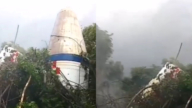【新唐人2011年3月1日讯】媒体披露中国部分“粮食产区”受重金属污染。专家指出,中共政府允许地方拥有中小矿产开发的审批权,导致“一哄而上”的采矿乱象。绝大多数矿山只为了开发极少数矿石,却破坏了人们赖以生存的自然环境。部分受污染的土地要等一百年后才可能回复。
《中国经济周刊》2月22号报导,中国大陆因滥采、滥挖矿产,部分农田受到重金属严重污染。以云南省红河州个旧市为例,这个被称为“锡都”的小镇,面积1587平方公里,超过45万的人口(45.33万),蕴藏锡矿超过90万吨,占全国三分之一。随处可开挖的锡矿,虽然让村民很快富裕起来,不过,因政府没有妥善规划,形成“全民办矿”的乱象,伴随锡矿而来的却是有毒物质-“砷”,当地因“砷中毒”出现了几个“癌症村”,人民平均寿命不足50岁,被污染的土地和地下水难以回复,清水和蔬菜都要到几百里外去买。
根据中科院“地理科学与资源研究所”(环境修复研究中心)的论文资料显示,截至2008年,中国大陆因滥采锡矿,造成至少116.7万吨的“砷”散落在各地,相当于百万吨的砒霜,在雨水冲刷下污染河川与土壤。
不只云南,在广西环江毛南族自治县,百年一见的洪水,在2001年冲垮了上游废弃的尾砂坝,导致下游万亩多的农田遭到污染,有毒物质最高超标246倍,临近的刁江100多公里沿岸,全部污染。直到2004年,当地仍有六成田地寸草不生。专家忧心,毒水如经由刁江进入珠江水系,将污染整个珠三角地区,超过上亿人受害,污染的环境要等一百年后才可能回复。
不只如此,湖南、四川、贵州等部分地区,也成为重金属污染灾区。国土资源部曾公布,中国每年有1200万吨粮食遭到重金属污染,每年这些粮食足以多养活4000多万人,一旦流入市场,后果将不堪设想。
社科院工业经济所研究员罗仲伟认为,上个世纪80年代中期以来,中共政府实行“大矿大开,小矿放开,有水快流”的政策,允许地方政府拥有中小矿产资源开发的审批权,形成一哄而上,“全民办矿”的乱象。以广西环江为例,绝大多数矿山没有石排场和尾矿库,大量废石和尾矿就堆放在山上,除了暴雨来临时形成泥石流,尾矿中的有毒物质在雨水冲刷下逐渐扩散,污染周边环境。
另一个来源是裸露堆放的矿渣,在云南个旧巿,十几万吨“砷渣”已经裸露堆放在当地几十年,为阻止污染扩大,农民在周围堆砌了土坝,但有毒物质通过雨水进入地下水。附近农作物含砷量超标100多倍。
一位科学家告诉《中国经济周刊》记者,几年前他受邀到一处全国知名的粮食主产区检测重金属污染问题,结果令他震惊,他把监测报告交给当地一位高级官员,但这位官员想了很久说:这个情况非常严重,但目前我们无能为力,所以请不要告诉外界我看过这份报告。
这名记者追查发现,中科院“地理科学与资源研究所”(环境修复研究中心)有多篇学术论文,可能遭到掩盖,内容显示:广东连南、广西南丹、湖南常甯、湖南常德、湖南郴州等地存在大量废弃砷渣,周围农作物含砷量超过国家标准几百倍。
但是,“湖南国家粮食品质监测中心”向媒体表示,中心并没有检测粮食重金属含量的相关项目。另外,“湖南省粮油产品品质监测站”也说,单位没有针对湖南任何地区的粮食“重金属含量”做过检测,所以没有资料数据提供。
新唐人记者曾耀贤、周平综合报导
Excessive Mining Causing Heavy Metal Pollution in Crops
Some of China’s farmland has been contaminated
by heavy metal due to excessive mining enabled by
the lack of government control. Experts say that
such mining exploits small and medium-scale mines
at the cost of the natural environment.
Some polluted land will take 100 years to recover.
On Feb 22, China Economic Weekly revealed
the severity of heavy metal pollution in farmland
caused by excessive mining.
Gejiu, a county-level city Yunnan Province,
is known as “tin city”.
With a population of more than 450,000, Gejiu’s
tin reserves at over 900,000 tons account for
1/3 of the national total and 1/6 of global stock.
Due to the lack of government control,
as people profit from this natural bounty,
the accompanying toxic heavy-metal arsenic produced
in the mining process is left untreated,
causing cancer among residents. As a result,
the average life expectancy of Gejiu
is less than 50 years.
Local residents have to purchase water and vegetables
hundreds of miles away.
Research data released by the Institute of Geographic
Sciences and Natural Resources Research shows that
1.167 million tons of arsenic produced in mining
has been discharged into China’s environment by 2008.
In 2001, a tailing dam in Guangxi’s Huanjiang Maonan
Autonomous County collapsed in a major flood.
The floodwater laced with heavy metals inundated
fields along the 100-kilometer Diaojiang River.
By 2004, 60% of the contaminated land was not yet
farmable. Experts worry, if the polluted water
entered the Pearl River system,
hundreds of millions of people would be affected.
The environment will take 100 years to recover.
Other areas including Human, Sichuan, and Guizhou
also suffer from heavy metal pollution.
China’s Ministry of Land and Resources estimated,
each year 12 million tons of grain in the country
was contaminated, enough to feed 40 million people.
Luo Zhongwei, a researcher with the Institute of
Industrial Economics, believes local government,
which was given the power to ratify the exploitation
of small and medium-scale mines by the CCP central
government in 1980s, should be held accountable for
the chaotic situation in the country’s mining industry,
which is ill regulated and lacks overall planning.
Exposed mining waste is another source of pollution.
In Gejiu, hundreds of thousand tons of arsenic waste
has been left uncovered and untreated for decades.
The heavy metals are absorbed by crops through water
and soil pollution, causing local produce to contain
arsenic 100 times over the safety level.
A scientist told China Economic Weekly that he was
invited to examine the heavy metal pollution
in one of China’s major grain production areas.
He was shocked by the result and gave the report
to a senior official, who said,
the situation is serious.
But we can do nothing about it.
Please don’t tell others that I’ve read the report.
Investigation reveals that several scientific reports
by the Institute of Geographic Sciences and Natural
Resources Research may have been covered up.
Such reports showed severe arsenic contamination
in Guangdong’s Liannan, Guangxing’s Nandan,
and Hunan’s Changning, Changde, and Chenzhou.
Arsenic concentration found in crops in those areas
was hundreds of times over the national safety level.
However, both the Hunan National Grain Quality
Control Center and the Hunan Grain and Oil Products
Quality Control Station denied that any test on
heavy metal contamination in crops was ever conducted.
NTD reporters Zeng Yaoxian and Zhou Ping。































